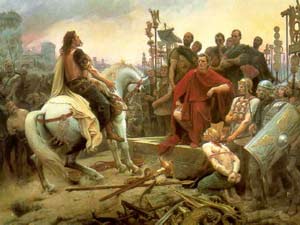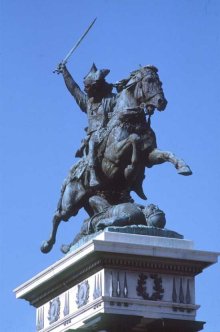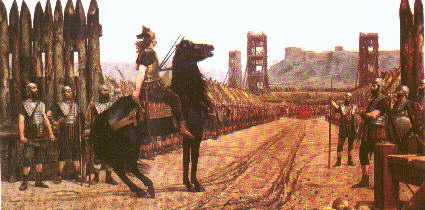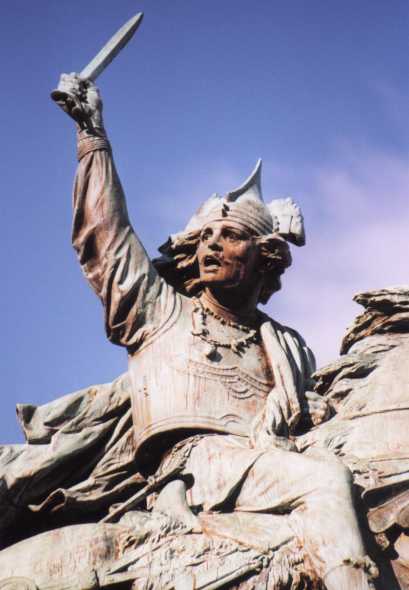|
The man who opposed an Empire
"Himself a man of boundless energy, he terrorized waverers with the rigours of an iron discipline."
Caesar
In 53 BC, when Caesar had left for Italy after the summer campaign season, the Gallic tribes rebelled under the leadership of Vercingetorix, who raised an army against the Roman legions still wintering in Gaul. Hearing of the rebellion, Caesar crossed the mountains in the south, digging through snow drifts six feet deep, to rejoin his troops. "The very vigour and speed of his march in such wintry conditions," says Plutarch, "was a sufficient advertisement to the natives that an unconquered and unconquerable army was bearing down upon them." To deprive the Romans of food and supplies, Vercingetorix had ordered a scorched-earth policy, and all the neighboring villages and farms were burned, "until fires were visible in all directions." But one tribe, already having torched twenty towns in a single day, refused to destroy its capital at Avaricum (Bourges), "almost the finest in Gaul, the chief defence and pride of their state." Vergingetorix relented and set about to help defend the fortified town, which held a large supply of grain so desperately needed by the Romans.
 Caesar began a siege that lasted twenty-seven days. It now was early spring 52 BC, and, in spite of incessant rain, two wheeled towers, eighty feet high, and ramps three hundred and thirty feet long, over which they could be rolled into place, as well as a high siege terrace, were constructed in less than a month. The Gauls did all they could to counter or destroy the siegeworks. As the towers increased in height, so the defenders raised their own. They attacked the soldiers at work and tunneled under the terrace to undermine it.
Caesar began a siege that lasted twenty-seven days. It now was early spring 52 BC, and, in spite of incessant rain, two wheeled towers, eighty feet high, and ramps three hundred and thirty feet long, over which they could be rolled into place, as well as a high siege terrace, were constructed in less than a month. The Gauls did all they could to counter or destroy the siegeworks. As the towers increased in height, so the defenders raised their own. They attacked the soldiers at work and tunneled under the terrace to undermine it.
As the terrace approached the height of the wall, the defenders became desperate. Caesar writes that "They felt that the fate of Gaul depended entirely on what happened at that moment, and performed before our eyes an exploit so memorable that I felt I must not leave it unrecorded." It was almost midnight when they again had dug under the terrace and set it on fire. Opposite one of the towers, a Gaul was throwing pitch and tallow onto the fire when he was killed by an arrow from a catapult. Another man stepped forward to take his place and he, too, was killed. Another came forward and also was killed. This continued throughout the night until the fire finally was extinguished.
The next day, it began to rain heavily and, as the defenders took shelter, one of the siege towers was moved into position. The Gauls, taken by surprise, were dislodged from the walls and, panicked at the sight of the Romans surrounding them, threw down their weapons and fled. Exasperated at the length and difficulty of the siege, the Romans massacred the inhabitants. No-one was spared, "neither old men nor women nor children. Of the whole population--about forty thousand--a bare eight hundred who rushed out of the the town at the first alarm got safely through to Vercingetorix."
As Caesar has Vercingetroix say, "The Romans have not won by superior courage or in fair fight...but by their expect knowledge of siegecraft, a special technique that we were unacquainted with."
 Later that year, Vercingetorix and his men were trapped in the stronghold of Alesia, near present-day Dijon. Caesar surrounded the oppidum and began to construct siege works. The defenders had food only for a month, and Caesar hoped to starve them into surrender before reinforcements could arrive.
Later that year, Vercingetorix and his men were trapped in the stronghold of Alesia, near present-day Dijon. Caesar surrounded the oppidum and began to construct siege works. The defenders had food only for a month, and Caesar hoped to starve them into surrender before reinforcements could arrive.
The circumvallation extended around the town for ten miles, too large to be occupied by the Romans. It therefore was made more secure by a series of defenses. First, facing the town, a trench twenty-feet wide was dug to protect against surprise attack. Six hundred and fifty yards behind this ditch two more trenches were dug, each fifteen feet wide and the inner one filled with water. Behind these trenches was a palisaded rampart twelve feet high, with a breastwork of earth studded with forked branches. Around the entire circuit of the wall, towers were erected every one hundred and thirty yards.
Still, there were attacks by the Gauls, and the siege works were strengthened even more. Tree trunks and strong branches were cut and sharpened, and buried securely in rows in front of the trenches. In front of them, diagonal rows of pits also were dug, each three-feet deep with a thick sharpened stake at the bottom and covered with brush to hide the trap. And, in front of these, blocks of wood were buried in the ground with iron barbs (stimuli) fixed in them.
Aware that Vercingetorix had sent for reinforcements to break the siege, Caesar had an similar line of defense constructed facing outward to protect against attack from a relief force.
Before it arrived, a tragic thing happened. By now, the food in the town had been exhausted, and it was determined that all those who could not fight were to be turned out. The inhabitants of Alesia, who had given refuge to Vercingetorix and his men, now were compelled to leave the town, together with their wives and children. Starving, they beseeched the Romans on the surrounding walls to take them in as slaves. But the population was refused any refuge and left to die of hunger between the two armies.
 Caesar writes that two hundred and fifty thousand infantry and eight thousand cavalry assembled to relieve the besieged town. But the Gauls had difficulty communicating across the Roman siege works that ringed the oppidum and were not able to coordinate their activities. Now surrounded, themselves, the Romans were able to repel the first assault. At midnight the next day, the Gauls suddenly attacked again, and Vercingetorix led his men out of the town in support. But it was too dark to see and, when the relief army came nearer the Roman defences, "they suddenly found themselves pierced by the goads or tumbled into the pits and impaled themselves, while others were killed by heavy siege spears discharged from the rampart and towers." Before he could even reach the trenches, Vercingetorix heard the army retreating and was forced back behind the town walls.
Caesar writes that two hundred and fifty thousand infantry and eight thousand cavalry assembled to relieve the besieged town. But the Gauls had difficulty communicating across the Roman siege works that ringed the oppidum and were not able to coordinate their activities. Now surrounded, themselves, the Romans were able to repel the first assault. At midnight the next day, the Gauls suddenly attacked again, and Vercingetorix led his men out of the town in support. But it was too dark to see and, when the relief army came nearer the Roman defences, "they suddenly found themselves pierced by the goads or tumbled into the pits and impaled themselves, while others were killed by heavy siege spears discharged from the rampart and towers." Before he could even reach the trenches, Vercingetorix heard the army retreating and was forced back behind the town walls.
Again, the relief force reassembled: "The Gauls knew that unless they broke through the lines they were lost; the Romans, if they could hold their ground, looked forward to the end of all their hardships....on that day, he said, on that very hour, depended the fruits of all their previous battles." There was a desperate struggle. The Gauls filled the trenches with dirt and bundles of sticks, pulled down the breastworks with hooks, and drove the Romans from the towers. But Caesar, his presence marked by a scarlet cloak, attacked with cavalry and additional cohorts. The Gauls broke and fled, the relieving army giving up and returning to their homes.
Vercingetorix was forced to surrender and allowed himself to be given up to the Romans. The Gallic chieftain languished in the Tullianum at Rome for five years before being publicly beheaded as part of Caesar's triumph in 46 BC. Two years later, Caesar, himself, was dead.
|









 View movies about ancient Rome!
View movies about ancient Rome! 

